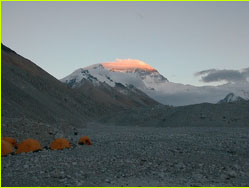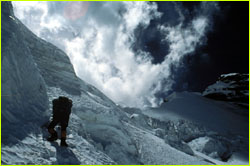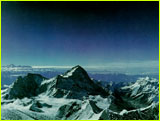 |
 |
 |
by Liesl Clark May 17, 1999 Editor's Note: Please be advised that our team has been experiencing power problems. Everyone has safely returned to Base Camp, and we expect to receive further updates to this Web site on Friday, May 21st. Steam from our mugs of milk tea hung in the air. At 4:00 a.m., it felt like the coldest morning so far, an odd moisture in the thin mountain air. As the sun rose, a lenticular cloud blanketed the summit and a white rime seemed to cover the whole mountain. Dave Hahn called in at 6:00 a.m. and reported that the ropes were icy. The climbing was slow, with the team having to pull frozen ropes from the mountain. At 6:00 a.m. they were still below the First Step. "It's cold up here," was all we could make out as Hahn's radio crackled in the early morning freeze. "Yeah, it's cold up here, but we'll keep moving on," came in Conrad Anker's booming voice. By 8:40 a.m. the climbers were at the bottom of the Second Step. Although Anker's free climb will be in the shadows, his assessment of the Second Step is that it would be easier to traverse around to the right by several hundred feet, where the Chinese ladder is, and free-climb a crack to the left of the ladder rather than tackle the Step head on. We continued to wait, light snow intermingling with the sun, as climbers from other expeditions started gathering around our dining tent. "It's a difficult decision, but there's a lot still ahead of us," Tap Richards struggled to tell expedition leader Eric Simonson at 9:30. "Jake Norton, Ang Pasang, and I are going to turn around." We could hear the disappointment in their voices, but knew they had just spent four nights above 25,000 feet—quite an achievement even for high-altitude climbers. "You guys are still young," Simonson reassured Norton and Richards. "You'll get another chance." We sat silently, wondering what Richards and Norton must be feeling up there, at the base of the Second Step, with the world at their feet. "It's an impressive piece of real estate," Simonson explained to us. He climbed this route in 1991 and remembers it well. "You look down and there's 10,000 feet below you, the whole North Face of Everest just drops off." Then, at 10:00, our sirdar, Dawa Nuru, came on and stated that he was ready to turn around. Now only Anker and Hahn were still headed toward the summit. We waited, nervously, for word on the next development in the climb. "Hey Eric," it was Anker, calling as though he were transmitting from the tent next door, his voice full of energy. "I just topped out of the Second Step. I tried two variations, free. First I tried going right, which looked like it was a line of weakness. But the rock was really loose and rotten, with bad fall potential. So I opted for the off width [a crack bigger than you can jam your hand or foot into] that's just to the left of the Chinese ladder that was put there in 1975. And I was able to knee bar to the top of it and got a size three-inch friend at the top of it and then I got a hand jam into the crack that I got the three-inch in, and then I had to step out. At that point the ladder was in the way. I had some edges in there, but I think due to the fact that I'm weak, more than anything, I stepped on the ladder. So one move of aid, but I did most of it free and I didn't have my back pack and my cylinder on."
"What I've really come to appreciate on this route so far is it's real climbing up here. There's a high commitment factor, a lot of exposed traversing," continued Anker. "You just can't, if you crack an ankle or something, you just can't start lowering down to 'la la marching', it's the real thing." Asked if they were going to continue on to the summit, Anker responded: "I'm this close. The weather is good, there's not a gust of wind. We might get some afternoon clouds like yesterday. If it's two hours away we're going to go for it." We watched them through a 600-mm lens, two dark specks, just like the ones Odell saw, at the base of the final pyramid. They were moving slowly, as is expected at 28,750 feet. 12:45 p.m. marked the toughest part of the climb for Anker and Hahn. Anker was in front, breaking trail through knee-deep snow, and the mountain clouded over, obscuring our view of the two set against the sky—the summit pyramid still before them.
It is the adamant words of Mallory's mentor, Geoffrey Winthrop Young, written soon after their disappearance, that will echo with us until we know more. Young was convinced that "after nearly 20 years of knowledge of Mallory as a mountaineer, I can say...that difficult as it would have been for any mountaineer to turn back with the only difficulty past—to Mallory it would have been an impossibility. ...the accident occurred on the descent (as most do) and that if that is so, the peak was first climbed because Mallory was Mallory." But the fact remains that neither Mallory nor Irvine made it back down to tell of their successful or ill-fated climb. Did they turn around, like Richards and Norton, at the base of the Second Step, or did they continue on to the summit? It is Edmund Hillary's description of his careful final steps to the summit that will always, nonetheless, remain the record of the first on top of Everest: "It was too late to take risks now. I asked Tenzing to belay me strongly, and I started cutting a cautious line of steps up the ridge. Peering from side to side and thrusting with my ice axe, I tried to discover a possible cornice, but everything seemed solid and firm. I waved Tenzing up to me. A few more whacks of the ice-axe, a few very weary steps, and we were on the summit of Everest." Unanswered Questions (May 25, 1999) Forty-Eight Yaks (May 21, 1999) On Top of the World (May 17, 1999) Summit Team Moves Higher (May 16, 1999) Still at Camp V (May 15, 1999) Snow Bound (May 14, 1999) Outsmarting the Weather (May 13, 1999) Last Trip Up (May 12, 1999) Up to ABC/The Rescue (May 11, 1999) The Image of Mallory (May 8, 1999) In Extremis (May 7, 1999) Pieces of the Puzzle (May 6, 1999) Dearest George (May 5, 1999) Mallory's Discoverers Return (May 4, 1999) Mallory Reported Found (May 3, 1999) Waiting in Silence (May 1, 1999) Up to the Search Site (April 30, 1999) To the North Col (April 29, 1999) Waiting out the Wind (April 28, 1999) Search About to Begin (April 25, 1999) Pitching a 1933 Tent (April 23, 1999) Early Camp Found at 21,750 Feet on Everest (April 20, 1999) Up to Base Camp (April 23, 1999) Photos: (1) Liesl Clark; (2) Thom Pollard (3) Roddy Mackenzie. Members of the press: click here for NOVA/PBS ONLINE "Lost on Everest" media relations contacts. Lost on Everest | High Exposure | Climb | History & Culture | Earth, Wind, & Ice E-mail | Previous Expeditions | Resources | Site Map | Everest Home Editor's Picks | Previous Sites | Join Us/E-mail | TV/Web Schedule About NOVA | Teachers | Site Map | Shop | Jobs | Search | To print PBS Online | NOVA Online | WGBH © | Updated November 2000 |
 Clouds blanket the summit of Everest.
Clouds blanket the summit of Everest.
 Ascending Mount Everest.
Ascending Mount Everest.
 See a QuickTime VR View from the Summit
See a QuickTime VR View from the Summit